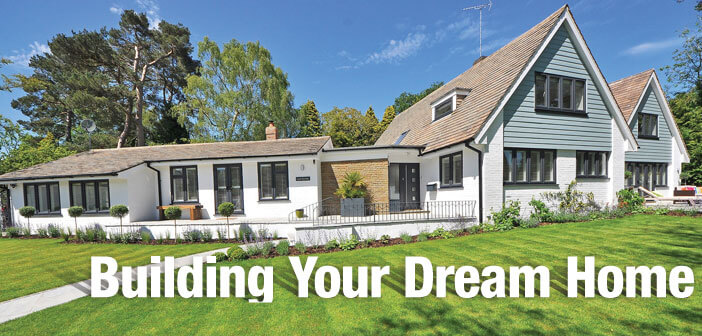Building Your Dream Home
When it comes to investing in the perfect place to call home, there are two options on the table: build or buy. For those who decide to embark on the first path and build new, there will be many decisions to be made ahead. At the end of the process, the reward is a finished product that’s a direct reflection of the people who it was created for, and who played an active part in helping to create it themselves. With everything completely customized based on the preferences of the homeowner, this is ideal for those who would rather plan for the construction of their own dream home instead of taking their chances on finding it while navigating the tides of the current real estate market (where it’s not uncommon for homes to be listed and sold in the same day).
{Builder Selection}
If you’re going to proceed with building a home, there’s a pretty good chance you’re going to enlist the services of a local home builder. While there are a limited number of other options one might consider depending on the circumstances, this is the most popular for a good reason. There’s already a process in place for everything that needs to happen along the timeline from start to finish, and you’re guided through it step by step.
There are production home builders and custom home builders in the area, and both are able to deliver quality homes. When deciding between the two options, it largely depends on how many choices you wish to make and how much design input you’d like to have during the construction process.
You might be asking yourself, “What’s the difference?” In short, it’s as follows:
Production builders are simultaneously building a community of homes based on a library of floor plans, each with a limited array of options to personalize the home.
Custom builders typically create one-of-a-kind homes, offering a wide range of design choices and with each built on a single lot.
With production builders, you’ll commonly find that the home and land are offered together as a bundled package. There are a range of house plans to choose from, and buyers are able to select their preferences in several key categories. Of the selection of homes on the menu, there are options priced for first-time, move-up, and luxury buyers.
Alternatively, with custom builders, it’s exactly like it sounds – everything about the home is built to the exact specifications of the buyer. Homes can be built on land you own or acquire, and you can supply a floorplan or commission one to be drawn up. You might choose to work with a separate architect or builder, or hire a company with design-build capabilities.
There are advantages associated with both, it’s just a matter of deciding which is best for you. Aside from this aspect, there are a number of other things that should be taken into consideration when choosing a builder. “When it comes to finding the right builder to work with, it needs to be a professional who is experienced, but also one who communicates well and prioritizes maintaining a good working relationship with the client,” says Stephanie Krueger-Ponce of Third Generation Builder. “Do your research, not just for inspiration and to get a better understanding of what you want, but on the credentials, reputation, and past work of the builders you’re considering.
Once you’ve narrowed it down to your top choices, call the Home Builder’s Association of Lincoln to ask if they’re members in good standing. It’s not just a given; there are a few that are not and it’s for a good reason. You’re making a major investment, one of the biggest ones you’ll make in your lifetime. You don’t want to get into the building phase only to find out that you’ve made a big mistake. And then you discover you’re at a point where there’s nothing you can do about it. Another way to avoid that scenario is to ask exactly who you will be working with on the project. You should meet with that person before getting started. You might start out by making contact with a company representative, but that’s not necessarily the professional who will be managing the job. It’s a process, and for the best outcome, you and whoever that person is will need to work together harmoniously and have a mutual understanding of expectations.
At Third Generation Builder, one thing we’ve tried to do is make our process so unbelievably easy that it’s as stress-free as possible, which is validated by the feedback we get from our clients. Many of our clients are also in the midst of major life events, such as planning for a wedding or having a baby, while they are building their new home. When it comes to guidance with making selections, understanding allowances, and negotiating wants and needs based on budget, we go through it all together step-by-step. It helps to decide the areas that you want to spend your money on ahead of time, so that’s where most of the focus is placed. The Spring and Fall Parade of Homes are great for getting ideas and inspiration, while also presenting a time to talk a little bit with a representative with the company and ask questions. Getting the plans in place is often where the most effort is concentrated; once we get started with building the home, the only thing that should be difficult is patiently waiting to see the finished product!”
In agreement, Michaela Harrison of the Home Builders Association of Lincoln also points out, “When you build a home, you have the opportunity to pick out every finish item in your home, from the trim type and color to the faucet in the kitchen sink. If your budget allows, you can include every item on your wish list – i.e. three-car garage, drop zone, open floor plan, walk-in pantry – instead of settling for a home that may only have a few of those things. When you build a new home, your home is personalized to your tastes and likes. It’s an opportunity most homeowners would love to have.”
She also notes a few key trends locally, “We are starting to see development in some new areas of Lincoln. Recently, some land to the east of 84th St. and Van Dorn St. was approved for development. Residential construction in Lincoln is strong right now, with many builders as busy as they have ever been.
As far as features of the home, a lot of people are choosing to build their new homes with outdoor living space. Along with sizeable decks and patios, the addition of outdoor fireplaces, kitchens and spaces designed for mounting a TV and integrating technology are now prevalent. Gray tones and painted woodwork are still very popular with interior finishes. Homeowners are using new flooring materials as well as modern twists on the traditional favorites. Options include hardwood, engineered wood, laminate, ceramic tile and luxury vinyl tile – and that’s just listing a few!
Functional homes for families are important as well. Drop zones for the on-the-go families, larger garages to hold all of the owner’s ‘toys,’ and large open kitchens with pantries are at the top of the list of amenities potential buyers are seeking.”
In conclusion, Harrison advises, “When considering building a home, we always recommend going to our website, www.hbal.org, and reading our page with ‘Tips on Choosing a Contractor.’ There is great advice on choosing a builder, things to look for, and questions to ask. Buying a home is the largest purchase most people will ever make, and it is important to have a positive experience while building. The Spring Parade of Homes is coming up May 14-21, which is a great opportunity to view new homes and talk with builders about building your new home. It is free to visit all 56 homes; hours are 6 p.m. to 9 p.m. weekdays and 1 p.m. to 6 p.m. Saturday and Sundays.”
From a standpoint of a Home Inspection professional, Randy King of King’s Home Inspections, LLC adds, “A general contractor or builder who is a teacher—who can educate on the sequence and steps necessary to make building a home happen—is definitely someone you want to work with on the project. I also encourage anyone looking into building a house to interview different builders and find one that they communicate well with, who is flexible, and who is able to give them an accurate estimate of final cost. Most builders offer at minimum a one year warranty, and most have clean-up crews that do final detail cleaning before the home is occupied as well as a crew that goes through the house and tests all lights, outlets, appliances, fireplaces, sprinklers, and so on to ensure proper operation. A good builder spells out his/her warranty, detailing exactly what is and is not covered. A booklet or workbook for the first-time homebuilder to use as a guide is also a very valuable resource.
As far as new trends in home building, Radon Resistant New Construction (RRNC) is now being promoted by the Nebraska Radon Program (a division of State of Nebraska Health and Human Services). The smart builder offers RRNC as an option during the design and construction process. We all know we have high levels of Radon gas nearly everywhere in southeast Nebraska. It only makes sense when building to install RRNC into your home to minimize the health risk from this cancer-causing gas. Installing RRNC during the building process is easy and inexpensive; it’s less costly than to retrofit a house later on down the line. RRNC methods include installing a vapor barrier under the floor and tying the tile drain system into a vent stack that exits the roof of the house. This creates a natural chimney effect to vent the soil gasses (including Radon gas) that may accumulate under your floor. In the event that Radon levels still happen to measure high, it is easy to install an electric fan on the vent stack in the attic space and convert the passive system to an active one. This also comes at a price that’s far less costly than installing a complete mitigation system.
The standards for uniformity on RRNC are still being ironed out, but the basic concepts are widely understood and agreed upon. Once built, it is wise to have your home tested for Radon gas every two years. As soil conditions change, it changes the pathways that Radon can enter your home.”
{Financing}
When planning to build a home, you’ll not only be working closely with a builder/general contractor/subcontractors/etc. but also with an experienced lender who will lead you through the financing process each step of the way. The process starts with getting pre-approved for long-term financing. Once that is in place, it’s a matter of having the discussion with the builder to determine who will be taking out the financing for the new construction and putting together a contract.
Mortgage rates continue to be relatively low, which benefits those building as well as buying. As far as costs go, it can be more expensive to build than to buy, but not always. The initial costs for new construction may be higher, but you can expect minimal expenses when it comes to repairs, decorating, and general upkeep for an extended period of time. With an existing home, there will likely be the need for replacing the roof, windows, utilities, etc. With a newly built home, everything is built to current code, and therefore should be less expensive to heat and cool. Most people do not realize that Homeowners Insurance is typically less expensive on a newly built home as well. Although construction loan rates will vary from one lender to another, usually the difference is minimal. Always keep in mind that the typical construction loan process is approximately six months long and during this period the customer only pays interest on the balance that has been drawn upon. Do not get overburdened with the construction loan itself–the bigger financial impact will come with the long-term financing. As such, look for a lender that has your best interests at hand for the long term.
{Realtor}
Although you’ll be in the capable hands of the professionals we’ve already mentioned, the purchase of a home that will be built especially for you often seems more complicated and intimidating than the purchase of an existing home listed on the market. Thus, it’s important to work with a real estate agent that’s experienced with the specifics of building a new home. Most builders will have an agent, or a team of agents, that represent them as the seller’s agent. However, it’s prudent for a buyer to enlist the services of an agent independent of the builder to represent them in the transaction. While the seller’s agent will be a great resource to utilize during the process, as they are the most knowledgeable about their client, a buyer’s agent is the one who will ultimately be responsible for looking after your best interests, because you are their client.
{Design Features}
When you build a house, you have the opportunity to select your favorite (fill in the blank) – you name it, there’s probably a host of options to pick from during the process of assembling the key components that will come together to form your dream home.
As far as the key exterior features of a new home, not accounting for aspects of the property itself such as the installation of landscaping or outdoor entertaining areas, you’ll be deciding on the siding, roofing, windows and doors. “Windows really accent the aesthetic of a new home while making it as energy efficient and secure as possible,” advises Jason Olberding of J-Tech Construction and J-Tech Solar. “Seamless siding has also become very popular here in Nebraska due to its durability and energy efficiency. We own our own siding machine, an investment that allows us to manufacture the siding on the job site. Our approach is to custom fit the home so there are no wasted materials and the client gets a first class product, and that’s not something you’ll commonly find with other siding companies here in the market. Also important to note regarding siding, although some products claim to be maintenance free, that is not always the case. I’d recommend going with a seamless metal alloy siding as opposed to vinyl or pre-painted cement board. This will prove to be a better investment down the road, and one that you will be thankful you made up-front.
Speaking of investments, a home is one of, if not the most, expensive things you’ll purchase in an entire lifetime. Make sure to do your research before entering any contracts, choose companies that are as dedicated to seeing your dreams come to life as you are, and stay involved during the process!”
Then, when it comes time to focus on establishing the landscaping and creating outdoor entertaining areas, you’ll have a blank canvas to work with, so it helps to consult with the professionals to get a plan in place. This might require tasks you’ll hire out, such as landscaping, concrete work or masonry, lighting, irrigation, and so on. There might also be some DIY work that you’ll have on the agenda, and a fantastic resource to utilize for materials is Outdoor Solutions, a retailer that boasts one of the largest properties to showcase its vast inventory in the area. Here you’ll find an impressive selection of decorative landscape rock, flagstones, boulders, mulches, topsoil, retailing wall materials, pavers, yard accessories, garden products, pond supplies, and so much more.
Now that we’ve talked a little bit about the outside, let’s move on to the interior design. As was previously touched on, there are things that will need to be functional. Then, the elements that are purely for aesthetics as well, but many you’ll find are a good combination of both. Flooring, countertops, cabinetry, furniture, and fixtures all fall into the “combination of both” category. You can achieve a beautiful home that stands up to the test of being lived in too. However, let the professionals be your guide here too because they can alert you to the things you need to know when making the important choices on materials, finishes, brands, and so forth. Again, it’s all about narrowing your focus and making smart decisions.
{Infrastructure}
Then, there are all of the things that are hidden from sight, but are just as important as the ones that are when you’re finally living in your new home. The main components of a new home as far as its critical systems go – electrical, plumbing, HVAC, ventilation, etc. – are responsible for creating and maintaining the ideal living environment. All of the functions of daily life are supported by these systems, and as such, they are the big ticket items in a home. When it comes to any of these, it’s not the place in the budget to sacrifice quality. Instead, consider it a wise investment in performance, efficiency, reliability, and longevity.
“Building your dream home is an exciting time,” says Matt Collins of Oak Electric, Inc. “There are so many aspects and variables to ponder. One of the most important pieces is the electrical. It is literally in every corner and room in the house. I have two pieces of advice to offer: First, I would like to encourage someone who is building their dream home to close their eyes and ‘live’ in the home. Think about how you would go about your daily life. What kind of lighting do you want? Do you want dimmers, can lights, mood lights? Where do you want your switches and outlets to be? As an electrician, we are constantly being called to make changes after the fact.
Second, being energy efficient isn’t just a popular trend; it’s a way of life. You can make your home more efficient by installing a high-efficiency heating/air conditioning unit and water heater. Furnish your kitchen and laundry room with high-efficiency appliances. Consider using LED lighting for both inside and outside your home. This is your dream home; with such a major investment, it’s not the time to cut corners just to save a penny.”
{Technology}
The technology that’s available today is pretty amazing, and there’s no shortage of options for integrating it into the plans for your new home. “Those who are building a new home are able to take advantage of the ability to run wiring wherever necessary, which is the ideal scenario,” says Doug Dushan of Echo Systems. “With the multitude of options for technology in the home, it is essential to bring in an electronics professional early on in the planning stage. Plan, plan, plan! I truly can’t emphasize that enough. Electronics and entertainment technology are no longer considered a part of the finishing touches like home décor and furniture, so I caution you not to think of them in that way. In order to look and function at its best, it must be planned early in the home’s conceptualization.
Having an electronics professional on board early will allow for collaboration with the other subcontractors during this design phase of the project, ensuring everything necessary is in place for the technology and its desired functions to be supported. That same professional who has been involved with the design will then be there to manage its implementation. We can help with planning wiring infrastructure, suggesting ways to aesthetically integrate technology, wireless network design, home automation, audio/video distribution, private theatre design, motorized shading solutions – there’s so much potential with new home construction.
Technology, when employed well, can add a great deal to our daily lives. Aesthetically integrated technology that supports a client’s lifestyle is our specialty. Mirror TVs, art lifts and invisible speakers seem to be increasing in popularity year-by-year. Wireless networks are also changing dramatically for the home. Whereas it used to be adequate to pick up a cheap router from a big box store, today’s homes and automation systems place significant demands on a home’s wireless network. We often employ enterprise-grade managed networks in homes to efficiently manage the wireless traffic.
The Lincoln residential market has been an exciting growth area for Echo Systems. We are finding there to be a conservative yet sophisticated clientele that place high value on aesthetics, reliability, and value. For those who are curious about what’s out there and want to see the possibilities for yourself, our state-of-the-art Experience Center, which features an actual multi-million dollar home, is a short drive from Lincoln. It allows clients to test out the latest trends in building, design, and technology before they pull the trigger on their own project.”
Smart homes are becoming much more common as technology becomes more accessible and more residential applications are developed. While we’ve mainly covered entertainment thus far, environment is another continent in the wide world of home automation. “Homeowners are definitely taking advantage of new, cutting-edge ‘smart home’ technology that improves the environment and living comfort, reduces energy consumption, and provides increased safety and security,” says Pat Killeen of Engineered Controls. “From the most state-of-the-art Wi-Fi enabled thermostats and zoning systems, to whole-house air cleaning systems, whole-house humidification and dehumidification systems, Zigbee and Z-Wave wired and wireless home security and video systems; it’s all quite impressive.
It’s no secret that heating and cooling account for the bulk of a home’s energy usage, and simply incorporating a programmable thermostat can make a big difference. Smart thermostats such as Honeywell’s Prestige Wi-Fi Smart Thermostat and the Ecobee3 allow the monitoring of temperatures at home from mobile devices and PCs. The thermostats monitor humidity and temperature and alter cooling cycles, resulting in energy- and money-saving opportunities.
Honeywell’s Total Connect Service provides a personalized web portal with mobile apps that allow the homeowner to stay connected to their home’s heating and cooling system as well as its security system from their smartphone, tablet or personal computer. With Total Connect, the homeowner can monitor and control their home at any time and from anywhere.
My advice to those interested in adding integrating technology into a new home is to make sure and do your research. There is plenty of information on the internet today that will make the average homeowner much more knowledgeable about what is available in the residential construction market than anyone realizes. It’s a great place to start, and then you are better able to articulate what you’re envisioning to the professionals so that everyone is on the same page. As previously mentioned, far too often we too are contacted by homeowners once they’ve already moved into their new house, only to find out that they did not get that they wanted. The moral of the story is to get involved, ask questions, know what you want, and know what you are getting BEFORE the decisions are made by everyone but you, the customer.”
{Safety}
As we previously touched on briefly with respect to Radon, Infrastructure, and Technology, there are a number of features that can be incorporated in the design of a new home for the safety of the future occupants who will live there. Today, it often goes hand-in-hand with the technology that’s incorporated into the home, although important enough to mention in its own right. Security systems and lighting, access points and privacy features, fire protection and detection of harmful gasses, and a designated area to take shelter in the event of severe weather are all worthy of consideration. The rule of thumb is to spare no expense when it comes to the safety of your family. Luckily, because costs are a concern for anyone building a home regardless of the price point, there are options available to fit within any budget. Selections of these features should be done early to account for integration. If any sacrifices need to be made, you’ll be able to do so knowing that the essentials are in place for your peace of mind. “A smoke detector is a staple in any home, and with advances in technology, it is now most often incorporated as part of a system as opposed to a standalone device,” advises Bob Sorensen of FireGuard. “If your house will have any appliances that use natural gas, an attached garage, or a fireplace, carbon monoxide detection should be a critical function of that system as well. Although almost everything that has to do with safety is supported by such amazing technology, another staple, the fire extinguisher, is one thing that hasn’t changed much with the times. It’s advised to keep one in the kitchen, and in homes with fireplaces, to keep a second one near that location in the home.”
{Insurance}
Prior to move-in day, once the home is complete of course, but in actuality, even before breaking ground on the empty lot where your new home will soon take shape, you’ll need to have homeowners insurance in place. Why? Liability coverage. In terms of risk, the biggest one involved with building a home is liability in the case of an accident on the construction site. A home insurance policy with the liability coverage option included will be in addition to the builder’s risk insurance policy, filling in any gaps that exist. It will also provide coverage in case of fire or storm damage, both of which are not exactly unlikely here in Nebraska. While most home builders offer a warranty covering the home for an extended period of time, you’ll also want to check in with your insurance agent to review your current homeowner’s policy and update as needed.
{Moving}
Moving to a new home, while exciting, is a big undertaking, and the process can be nerve-racking at times. In the case of building a new home, the timeline can potentially be subject to change, affecting the plans you have in place for the moving process. Working with an experienced professional moving company that’s flexible and can help you navigate any issues that arise is incredibly helpful. “A common problem we run into with new construction is an unplanned gap between when the homeowner has to be out of their current home and when the new home is complete and move-in ready,” advises Lee Saltzgaber of Heartland Moving. “This results in one of two scenarios. Option number one, they have nowhere to go and must add in a trip to a storage facility while temporarily staying with family or friends. Option number two, they are forced to move their date, maybe even a number of times. That close to the scheduled appointment, there’s no guarantee that the new date needed will be available, so they may have to wait even longer before they are settled.
Building a home is very time consuming, tends to be stressful, and becomes more so on both accounts the closer it is to being finished. The more packing you can get done early will make the end process much more manageable. If you are packing yourself, the goal is to pack anything that isn’t furniture in a box. The more stackable items are, the more efficient your mover can be. The more efficient the process, the less it will cost you.
Moving can be a very involved process. Like any project, moving is usually way more work than is first anticipated. We always stress the fact that you are able to do as much or as little as you like, and then leave the rest up to us. When working with any moving company, always get an in-home estimate that can be explained and makes sense. An in-home estimate allows a professional to guide you on how to prepare, how soon to get started, and how to meet deadlines. One of the biggest mistakes that we see is that customers start preparing too late and cannot get caught up. Start early!”
While this is by no means an exhaustive list of everything you’d want or need to know before you commit to building your dream home, it’s a great start. If you are or will soon be in the market for a new home, it’s advantageous to explore the options for both building and buying. If the perfect home isn’t out there, or it is but it’s not for sale, you can still make your dream a reality and build it from the ground up!










